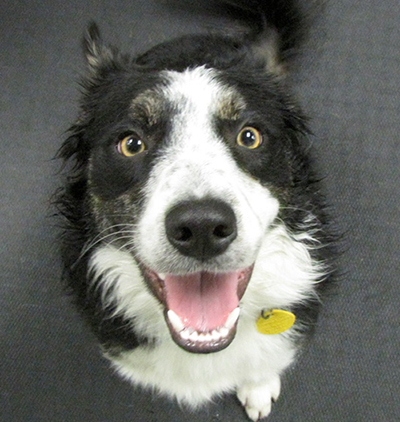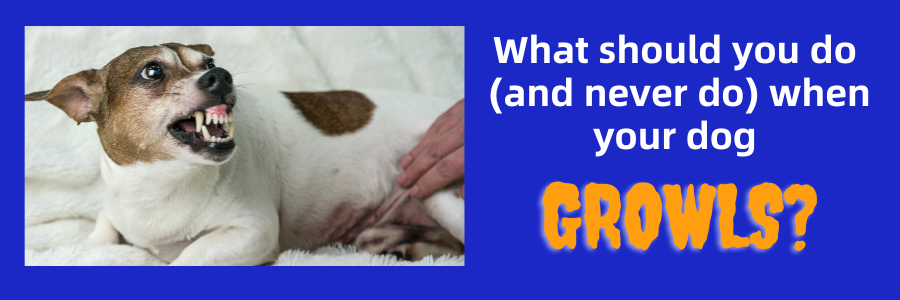Does your dog sometimes growl at you? Read on for some important information.
![]()
By Mindy Cox, BS, CPDT-KSA
When we acquired our border collie, Decker as an adolescent, he had already had 3 other homes. He was quirky, to say the least. One of his issues was that he hated to be physically prodded or moved. If he was on the bed with my husband and me and was taking up too much room, we might prod him with a foot to move him over. He would immediately tense up and begin to growl. Many pet parents in this situation would have been angered, thinking that “there is no way this dog is going to have control over me”. But of course, we knew that dogs don’t think that way; our dog was simply telling us that he was uncomfortable being handled or poked. Instead, we taught him, “Decker, move” and he learned to gladly move over when asked. Crisis averted!
Growling can be understandably scary for pet parents. Besides fear, it can elicit all kinds of feelings including anger, surprise, confusion, and misunderstanding. When we get emotional in the face of our dog’s growling, it is not helpful to either the dog or the pet parent. If we understand what a growl means, we can respond appropriately and change it in real-time or preempt it to keep it from happening again.
What does it mean?
Growling does not indicate that your sweet, lovable smoochie-face is a mean dog, or that he is trying to take over your life or the world and be “dominant” (which is an outdated notion and the furthest thing from your dog’s mind). But your dog is trying to communicate with you. Here is what a growling dog may be feeling:
— Threatened (by a real or perceived threat);
— Worried or scared of a thing, event, or situation;
— In pain or uncomfortable;
— Needing to protect a valued resource such as a bone, toy, food, person, or specific location;
— Excited. Growling can be a normal component of play.
What you should NOT do
Do not lash out in anger or take it personally. You should not reprimand or physically punish your dog. Most of the time, growling is related to stress and anxiety. It is a distance-increasing signal. That means your dog wants the object of his growling to go away. If you punish your dog, you are increasing his stress and his behavior will ultimately worsen. You may be able to eventually punish away the growl, but you most certainly will not change your dog’s emotional state. In many cases, instead of giving you the warning of a growl, your dog will escalate to a bite.
What you should do
You should understand and respect your dog’s needs enough to back away and assess the situation. If you can change the situation, do so. If you need to leave the situation, do that. If it is something you were starting to do, such as physically moving your dog, stop doing that.
5 TIPS to change your dog’s stressed state to lessen growling.
#1: Understand your dog’s emotional state and the situations that create it.
Learn to recognize the body language giveaways that occur before your dog growls. They can include muscle tensing; looking away; moving away; yawning; lip or nose licking; ears back; eyes turned away (the whites may be showing); and even scratching himself. If you can read the subtle signals and respond appropriately, your dog may never need to growl, or worse, bite.
#2: Consider a medical problem.
Have your dog thoroughly worked up medically for any underlying physical issues. More than 50% of behavior issues are related to a physical malady. Even great pet parents are often unaware of underlying medical problems. (Read more on this topic.)
#3: Manage the situation.
Stop placing your dog in a situation that elicits the growling and he will not do it. Think carefully about what causes your dog to growl (or do anything you don’t like, for that matter). Can anything be adjusted? Here are some ideas. (Remember, your attitude remains neutral or happy. We are not intending anything as a punishment, which only increases stress and conflict.)
-
- If your young child is pestering your dog and your dog is growling in response, please keep the two separated using baby gates or pens.
- Does your dog growl at the other dog during meals? Feed them in separate rooms.
- If your dog growls every time she is picked up, stop doing that and find an alternative way to move her.
- If growling at visitors is the issue, place your dog in another room with something fun to do before the guests arrive.
- If your dog growls at other dogs, cars, or anything on a walk, increase the distance from the stimulus; move far enough away that your dog feels safe. (Change this behavior by taking the effective online program Your Reactive Dog: From Anxious to Zensational.)
- Growling is often a normal component of play. Manage it by interrupting the play often for lots of calming pauses so that it does not escalate into overstimulation and, in the case of dog-dog play, possible altercations. When Decker growls like Cujo when we play tug, I know he is really getting into the game and having a good time. (He is also trained to release the toy when asked and settle down when the game is finished. Watch for an upcoming issue on how to create appropriate play.)
#4: Distract or redirect your dog.
If your dog growls because he does not like to be physically moved off the couch, call him off by clapping your hands, or shaking a jar of treats. Then place a food toy on his bed to keep him occupied. If you need to take an item away from your guarder, make a treat trail by placing treats about 1-2 inches apart toward and into another room. When your dog gets inside, close the door before picking up the article in question. Keep your dog’s stress levels low in as many situations as possible. If your dog sees something at a distance, such as a squirrel, and you know it may become an issue, pull out a ball, tug toy, or treats and keep your dog’s attention.

This is Decker, the companion of Mindy Cox, the author. You wouldn’t guess that a growl would come out of that sweet face!
#5: Train your dog.
When paired with good management, training, and behavior modification create the most permanent, long-lasting results. As mentioned in the story about my dog Decker (in photo at right), you can train your dog to do the things you want such as getting off the couch, leaving something he can’t have, or going to a safe place to settle such as a bed or crate. If it’s related to a fear issue, you can change your dog’s emotional state and modify the behavior causing the growling, such as in the instance with the guarding of valued items, or growling/barking/lunging at things on walks. (Find a great solution for problem walks on our website.)
Safety is always paramount.
Consider muzzle training. While muzzling does not change your dog’s emotional state, in certain situations such as the veterinarian’s office, a muzzle can keep everyone safe and allow needed procedures to finish quicker and more successfully. Condition your dog to accept the wearing of a basket muzzle (when supervised) so he feels less stressed about its use when needed.
If growling is a common situation in your household, or you are worried that someone may get hurt, reach out to a qualified veterinarian, or behavior specialist for help. Growling is often a cry for help. Your dog deserves that help and so do you!
Below, board certified veterinary behaviorist Dr. Lisa Radosta guides you on what to do, not do, and what it means.
Article written and narrated by Mindy Cox, CPDT-KSA
Listen to this post:

